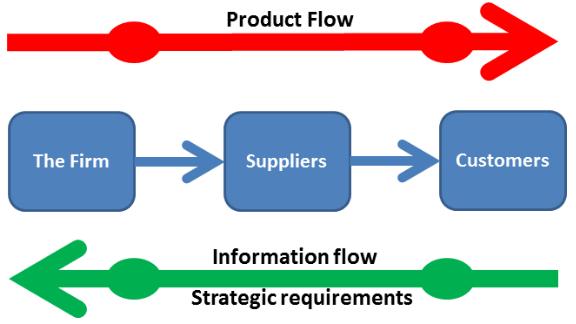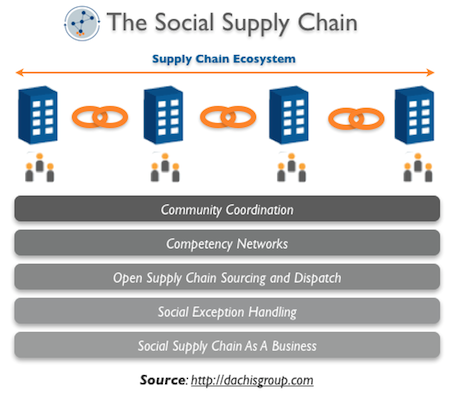Before we talk about anything “social” as it pertains to the supply chain, let’s start off with just the plain ‘ol supply chain. There are a few definitions of “supply chain” but I like the one put forth in the book “The New Supply Chain Agenda” by Rueben E. Slone, J. Paul Dittmann, and John T. Mentzer which is:
“The activity that manages the flow of information, money, and material across the extended enterprise, from supplier through the functional silos of the firm to customer.”
Here is the visual I reproduced from the book which shows how materials and information should flow across the extended enterprise.

If we take a look at the above graphic we can see that products flow from the firm to the suppliers to the end customers. However, the business decisions around those products are based on information that flows from the customers to the suppliers to the actual firm; this dictates the strategic requirements necessary to make the supply chain “work.” The supply chain actually includes quite a lot of things such as:
- physical capital needed to manage and distribute that inventory
- manufacturing products
- slow moving/fast moving inventory
- transportation costs
- warehousing costs
- inventory turnover
- pretty much anything that has to do with any type of inventory
I’m by no means a supply chain expert and I know this stuff can get pretty complex but hopefully everything makes sense so far.
So if this is a supply chain then what’s a “social” supply chain?
Social supply chain management seeks to incorporate social data, network, and interactions into the supply chain. So what does this mean?
Let’s say you release a new product that is being distributed across a particular region, say California. Through monitoring the social web your organization discovers that there is a strong demand for the product in another nearby geographic location such as Nevada. You take this information and alter your supply chain dynamically to address this growing demand. You might alter a delivery route that stops by Nevada before heading to San Francisco. Again, the idea here is that you are able to alter your distribution based on social data.
Let’s take another example. Say you are looking to distribute products to a particular area and then based on social data you find out that your shipments won’t get there in time (due to weather, a natural disaster, or anything else) you can alter your supply chain based on that information to mitigate time delays and loss. (other types of risk identification are also possible).
The “social” supply chain also leverages supplier communities to make business decisions and improvements to the supply chain, think of your standard enterprise collaboration solutions but geared specifically at suppliers. Vendors such as Rollstream and Elemica specialize specifically in these supplier community solutions (which you can learn more about by visiting their sites).
There aren’t many visuals out there which really show how a social supply chain works or what it looks like however I did find one create by Dion Hinchcliffe which is a good start (which came from this post).

There’s a lot to be said about the social supply chain but if we look at the image created at the top which depicts a traditional supply chain, then how exactly is a social supply chain different? In my opinion there are two differentiating factors of a social supply chain:
Feedback mechanisms
As Dion mentioned in his post which I linked to above, feedback mechanisms can vary from all sorts of channels and mediums, whether they be APIs which developers can use to build mashups or whether that feedback comes from supplier communities or directly through a tweet. I don’t want to get into too much detail but many companies are now using RFID tags which basically give products a “voice” to communicate with their handlers (you can find out everything you need to know about a product or inventory based on an RFID tag). The key here are the new channels and methods of information flow and feedback, but at the end of the day they still fall under the basic premise of how a regular, plain, old, boring, supply chain functions.
Response time
Responses to changes in the supply chain or to suppliers can now be made in almost real-time via social channels, this was not possible even 3-5 years ago. It’s the same concept that we apply to basic social media interactions. Nowadays you can find out about and respond to someone in real-time that is talking about you on the web.
I’m still doing a lot of research/learning around social supply chains but the concept and idea is very interesting. I don’t think at this point in time (as with Social CRM) there is a definite list of characteristics that make a supply chain “social.” I also didn’t come across any companies that are using social supply chains (perhaps components such as RFID tags). This is going to be a new topic I’m going to start exploring here along with Enterprise Resource Planning (ERP) so stay tuned!
Some thing to think about, how does this fit with Social CRM, what are the social supply chain use cases, how does the social supply chain integrate with an organizations CRM and/or ERP systems? I certainly don’t have all the answers here, but it’s interesting to think about these things as we continue to see the evolution of business.
In the meantime, what do you think about social supply chain management, does it make sense, do you even think it really exists? The floor is yours!

Comments